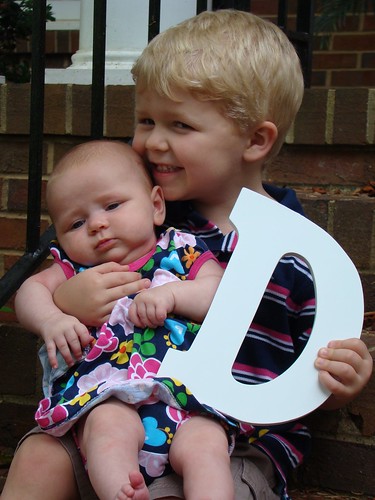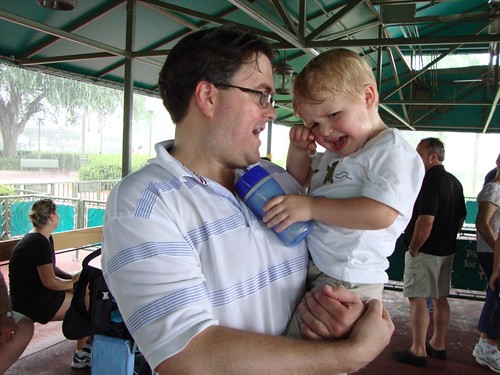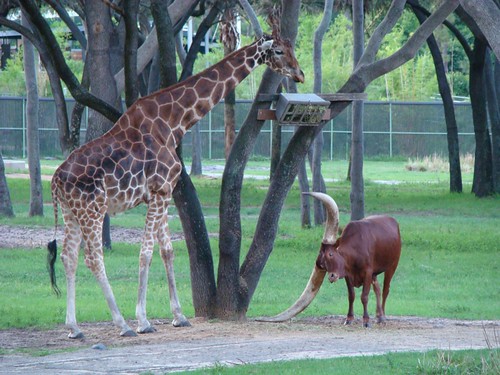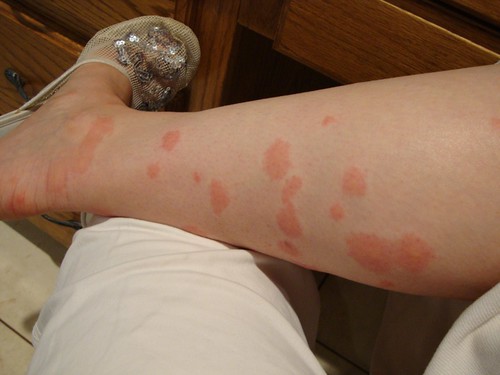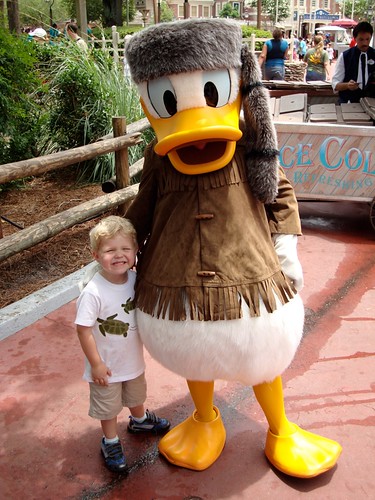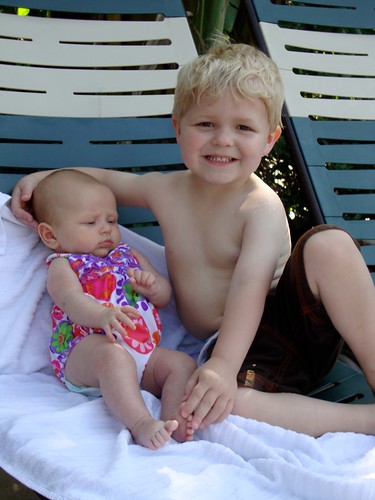I am a scientist, so of course I am an experimenter by nature. Since I've become an administrator, I don't get to do experiments anymore. However, having a new baby in the house has given me a new outlet for my desire to experiment. Babies are, by nature, completely and utterly baffling in their behavior which leads to the development of all kinds of hypotheses. Of course, most baby experiments take place in the wee hours of the morning - thus, the minimally-functioning brain characteristic of this time period (and let's face it, all time periods at the moment) makes proper study design and data interpretation more difficult.
Here are a few of my experiments thus far (Note: IRB approval was sought but our house does not have an IRB):
1.
Is it gas?Observation: Baby goes to sleep peacefully at 8 pm. Baby wakes up screaming as if in pain at midnight. Screaming is accompanied by sounds of gas leaving the body through various openings. Is baby possessed? Is gas cause or consequence of waking up and screaming like a banshee?
Null hypothesis: This is just a normal - albeit exhausting - feature of one month old babies.
Alternative hypothesis: Gas is the cause of waking up screaming like a banshee.
Study Design: At one-month check-up, ask doctor why normally agreeable baby turns into a screaming, farting mess in the middle of the night. Doctor indicates that time, or possibly medical intervention will alleviate this problem. Stumble, bleary-eyed, into drugstore. Purchase 'Infant Mylicon Drops'. Administer 0.2 mL 'Infant Mylicon Drops' to baby before 8pm feeding, before midnight feeding, before 2 AM feeding, before 4 AM feeding, before 6 AM feeding... (some of these data points will require nightlight technology, as well as for eyes to be open).
Outcome: As doctor probably predicted, consistent application of 'Infant Mylicon Drops' made little impact on the nocturnal screaming, farting behavior. What did make a difference was baby getting older. Accept the null hypothesis.
2.
Pacifier woesObservation: Baby likes to suck on things. Often that thing is me. Baby also enjoys sucking on a pacifier (Avent brand - they are the least ugly) (that is honestly exactly how I came to the decision to use this brand). At least I think she does - she cannot keep that sucker in her mouth for more than ten seconds. This pisses baby off to no end. I am certain that if she could keep the pacifier in her mouth, she'd be peaceful and happy all the time, and sleep beautifully all night (see experiment 1).
Null hypothesis: Newborn babies are incapable of keeping a pacifier in their mouth regardless of brand.
Alternative hypothesis: Baby does not like this particular brand of pacifier, and would prefer something uglier.
Study Design: Purchase 2 'Soothies' brand pacfiers at Target.
aside: For those of you who do not have babies, Soothies are the kind of pacifiers they usually use at hospitals. Thus, I thought these would be the perfect, never-fail pacifier. After all, that must be why hospitals use them, right? The downside to Soothies pacifiers are that they are really crazy looking. They are made of a single piece of molded rubber, so the part that goes into the baby's mouth is like a tube that you can see into. And since the rubber is sort of clear-ish, you can SEE THE BABY SUCKING ON IT. It's all very creepy.
Ahem. Back to the study.
Purchase 2 'Soothies' brand pacifiers. Attempt to get baby to suck consistently on Soothies pacifier. Attempt to get baby to suck consistently on 'Avent' pacifier. Post question on local mommy group internet forum asking for experiences of newborns with pacifiers. Hope against hope that one of the experimental conditions will be successful (that's kind of like regular lab work too, isn't it).
Outcome: Neither pacifier stayed in baby mouth for any significant time period. Accept the null hypothesis. Reject the creepy Soothies pacifiers.
Supplemental data: Now that the baby in question is 10 weeks old, the pacifier stays in at least long enough to do it's job. She still doesn't sleep beautifully all night though (see experiment 3).
3.
Swaddle? No swaddle? Half-swaddle?Observation: Babies have spent their entire lives up until birth crammed into a uterus. Babies also have a powerful startle reflex. Thus, babies feel more comfortable wrapped up, straitjacket-like, in a swaddling blanket. The popular parenting literature supports this observation. Indeed, current baby's older brother slept better when swaddled, at least for the first few months. However, current baby also really likes to suck on her hands or whatever else is available (see experiment 2). Mother is awoken each night to grunting and crying sounds of baby trying desperately to free one hand and position it such that she can suck on it.
Null hypothesis: Baby will sleep the same whether swaddled or not swaddled.
Alternative hypothesis #1: Baby sleeps better swaddled.
Alternative hypothesis #2: Baby sleeps better unswaddled.
Study Design: Baby dressed in onesie and swaddled for sleeping from birth. Swaddling blanket utilized is the SwaddleMe blanket by a company that seems to be bought out by another company every time I purchase one (again, this is very much like lab science). Baby's normal sleeping pattern is to sleep from 8 PM until midnight or 1 AM, nurse and go back to sleep, wake again at around 4 AM to nurse, wake again at around 6 AM to nurse, and sometimes go back to sleep, sometimes not.
- First phase of study began when experimenter noticed at first night feeding the great pains baby was taking to wrestle one hand into sucking position. Experimenter began to undo the arm part of the swaddling blanket and rewrap it under baby's armpits, thus freeing both baby arms for the remainder of the night. This pattern continued for several nights and sleeping durations did not change, so experimenter decided to stop swaddling baby completely.
- For phase two of study, baby was dressed in a sleeper and not swaddled.
- For phase three of study, baby was dressed in a onesie and a fleece 'sleepsack'-style sleep gown.
- For phase four of study, multiple methods were used over the course of a single evening (also known as the PANIC PHASE).
Observations: Given the success of phase one (swaddled for part of the night, arms later freed), phase two (unswaddling) was predicted to go smoothly. Indeed, sleep patterns did not change for the first two nights. Because this was a terribly planned experiment, an additional variable was introduced during Phase two - baby received two-month vaccinations. These two-month vaccinations can have varied effects on babies. Older Brother completely lost his shit in the days following the two-month vaccinations. Current baby appeared to have little to no reaction to vaccinations, other than to sleep all. day. long. on the actual day the vaccinations were received. Because the effects can be so variable, the impact of this stimulus on the current study is not immediately known. Anyway. Sleep patterns started to break down in phase two (unswaddled). First sleep period became shorter, which resulted in more total evening feedings (since remaining feedings continued to occur at 2-3 hour intervals following initial feeding). This also resulted in a significant decrease in the mental capacity of the experimenter. Thus phase three (sleepsack) began, on somewhat of a whim. The idea behind phase three was that it would replicate the half-swaddled condition - legs somewhat contained, arms freely roaming. Phase three lasted only two nights before experimenter began to lose her ever-loving mind. Experimenter reverted to phase one of the study. As existing swaddling blankets were becoming too small, a larger fleece swaddling blanket, used previously for Older Brother, was unearthed. Yes, it is ridiculously hot here in Florida in May, and yes, our A/C may be a little bit wonky. However, experimenter was a little bit desperate. In the repeat of phase one, baby slept until 2:30 am - longer than any sleep period previously. Buoyed by this success, experimenter purchased a second, lighter-weight swaddling blanket in the larger size. Unexpectedly, night one in the new swaddling blanket was a disaster. The new blanket appeared to be even easier for baby to escape. Experimenter feared she had not followed the wrapping protocol exactly, and repeated the experiment the next evening. However, this too resulted in chaos. At approximately 1 AM, phase four began. At each successive wake-up the conditions were changed. The experiment was aborted at 6:30 AM when the experimenter was found brain-dead and quivering in her bed.
Results: Who the hell knows. This experiment is ongoing (back in phase two).
